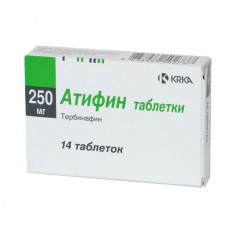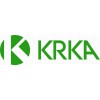Expiration date: 07/2026
Structure and Composition:
Tablets. 1 tablet contains terbinafine hydrochloride 140.5 or 281.0 mg (Corresponding to the base 125 and terbinafine 250 mg)
Excipients: lactose monohydrate, croscarmellose sodium MCC povidone talc (hydrous magnesium silicate), silica colloidal anhydrous magnesium stearate
in blister 7 pcs. In the paper cartons 2 or 4 blisters.
Description pharmaceutical form:
Round, biconvex, white or nearly white, with a notch on one side and a facet.
Pharmacokinetics:
When taken orally, it is absorbed well over 0.8 hours absorbed half of the dose over 4.6 hours - half the dose is distributed in the body. After 1-2 hours after a single oral dose of 250 mg Cmax plasma drug reaches 0.97 g / ml. Bioavailability is 80%. Food intake has no effect on the bioavailability of terbinafine.
Terbinafine binds extensively (99%) to plasma proteins, in tissues quickly spreads penetrates into the dermal layer of skin and nail plate. It penetrates the sebum and accumulates in high concentrations in the hair follicles in hair, skin and subcutaneous tissue. Within a few weeks of treatment the nails accumulates in concentrations providing fungicidal activity. T1 / 2 - 16-18 hours, T1 / 2 terminal phase - 200-400 hours.
Biotransformiroetsa in the liver 80% of the dose to inactive metabolites excreted in the urine as metabolites, the remainder (20%) - with the feces. Do not cumulated in the body. Age of the patients did not affect the pharmacokinetics of terbinafine, but elimination may be reduced in patients with lesions of the kidneys and liver, resulting in high concentrations of terbinafine in the blood.
Provided with breast milk.
Description of the pharmacological actions:
Terbinafine belongs to the allylamine group, it has a broad spectrum antifungal activity. In low concentrations it has a fungicidal effect on dermatophytes: Trychophyton - T. rubrum, T. mentagrophytes, T. tonsurans, T. verrucosum, T.violaceum) Microsporum canis, Epidermophyton floccosum), fungi (eg Aspergillus, Cladosporium, Scopulariopsis brevicaulis), yeasts, especially Candida albicans, and some dimorphic fungi.
On Candida fungi and their mycelial form has, depending on the type of fungus fungicidal or fungistatic.
Terbinafine breaks early stage of the biosynthesis of the main component of the fungal cell membrane ergosterol by inhibiting the enzyme squalene epoxidase. Squalene epoxidase is not related to cytochrome P450 (SYR450), terbinafine therefore does not affect the metabolism of hormones and drugs whose metabolism is associated with SYR450.
When oral administration is accumulated in the skin, nails and hair in the amount of a fungicidal action.
Systemic treatment of multi-colored lichen, caused by Malassezia furfur, is inefficient.
Indications:
- fungal infections of the scalp (trihofitia, mikrosporiya)
- fungal infections of the skin and nails caused Trychophyton (T. rubrum, T. mentagrophytes, T. verrucosum, T. violaceum), Microsporum (M. canis, M. gypseum) and Epidermophyton floccosum
- onychomycosis
- heavy, spread ringworm smooth skin of the trunk and limbs requiring systemic treatment
- candidiasis of skin and mucous membranes.
Contraindications:
Hypersensitivity to terbinafine and other components of the drug, pregnancy, lactation, children under 2 years of age, because there is not enough data on the use of the drug children weighing less than 12 kg.
Precautions: hepatic and / or renal failure, alcoholism, blood diseases, cancer, metabolic diseases, pathology limbs psoriasis.
Application of pregnancy and breastfeeding:
Admission terbinafine during pregnancy is contraindicated because of the lack of sufficient information about its safety during pregnancy.
Terbinafine is excreted in breast milk, so his appointment is contraindicated during breast-feeding.
Side effect:
Side effects are usually mild and moderate severity and are temporary in nature.
On the part of the digestive system organs: often - a sense of fullness, indigestion, nausea, loss of appetite, abdominal pain, diarrhea, and sometimes - a violation of taste perception (including its loss), which is recovered in a few weeks after cessation of treatment, rarely - cholestatic jaundice, hepatitis, asymptomatic increase in liver transaminases. Despite the failure to prove causation of these disorders with taking terbinafine, in the case of hepatobiliary dysfunction treatment Atifinom should be discontinued.
CNS: rarely - paresthesia, hypoesthesia, dizziness, rarely - depression, a sense of increased anxiety.
From the musculoskeletal system: often - arthralgia, myalgia.
From hemopoiesis system: very rarely - neutropenia, agranulocytosis, thrombocytopenia.
Immune system: often - urticaria, erythema multiforme, rare - systemic allergic reactions (serum sickness like reaction, angioedema), very rarely - severe skin reaction (toxic epidermal necrolysis, Stevens-Johnson syndrome, photosensitivity). With the progression of skin rash terbinafine should be discontinued.
Other: often - headache, malaise, fatigue, very rarely - worsening of psoriasis, increased hair loss.
Drug Interactions:
Virtually no effect on the clearance of drugs metabolized with participation of cytochrome P450 (such as cyclosporine, terfenadine, tolbutamide, triazolam, oral contraceptives).
It inhibits isoenzyme CYP2D6 and prevents the metabolism of drugs such as tricyclic antidepressants and selective serotonin uptake blockers (eg desipramine, fluvoxamine), beta-blockers (metoprolol, propranolol), antiarrhythmics (flecainide, proavfenon), MAO-B inhibitors (eg selegiline) and antipsychotics (eg, chlorpromazine, haloperidol) funds.
Medications Inductors SYR450 enzymes (such as rifampicin) may accelerate the excretion of terbinafine from the body.
Medications SYR450 inhibitors (eg cimetidine) may slow the metabolism and excretion of terbinafine from the body. With the simultaneous use of these drugs may require dose adjustment of terbinafine. Possible disruption of the menstrual cycle while taking terbinafine and oral contraceptives.
It reduces the clearance of caffeine by 21% and prolongs its half-life by 31%. It does not affect the clearance of antipyrine, digoxin, warfarin.
Ethanol and other hepatotoxic drugs increase the risk of hepatotoxic effects.
Dosage and administration:
Inside, after a meal.
Duration of treatment and dosage regimen set individually and depend on the process of localization and severity of the disease.
Adults - 250 mg (1 tab.) 1 time per day. Dosage for children is listed in Table 1.
Table 1
| The child's body weight | The dose one time per day |
| 12–20 kg | 62,5 mg (1/2 tablet 125 mg) |
| 20–40 kg | 125 mg (1 tablet 125 mg) |
| More than 40 kg | 250 mg (1 tablet 250 mg) |
The length of treatment varies and depends on the indication and the severity of the infection (Table 2).
Table 2
| Disease | Length of treatment |
Skin Infections | |
| Trihofitii stop | 2–6 week |
| Trihofitii smooth skin and jock itch | 2–4 week |
| Skin Candidiasis | 2–4 week |
| Sometimes the symptoms of the infection may disappear a few weeks after the end of terbinafine | |
Infections hair and scalp | |
| Ringworm (a mostly children's infection) | 4 week |
Infections of the nail plate | |
| Onychomycosis | 6–12 week |
| Infections of the fingers | 6 week |
| Infections toes | 12 week (In some cases, a treatment for 6 months or more) |
| In patients with slow-growing takes a long nail treatment (more than 3 months). The clinical effect may be noticeable within a few months after the end of treatment depending on the time required for the regeneration of the nail tissue | |
When expressed violations of the liver and / or kidney (Cl creatinine <50 ml / min or serum creatinine concentration in the blood -> 300 umol / L) - 125 mg 1 time per day.
Overdose:
Symptoms include nausea, vomiting, pain in the lower abdomen in the epigastric region.
Treatment: gastric lavage, followed by the appointment of activated carbon and / or symptomatic therapy.
Special instructions:
Irregular use or premature discontinuation Atifina treatment leads to relapse.
On the duration of therapy can influence factors such as the presence of comorbidities, the state of the nails in the beginning of treatment.
If after 2 weeks of treatment of skin infection is not marked improvement, it is necessary to re-determine the causative agent and its sensitivity to the drug.
Systemic application in onychomycosis is justified only in case of total destruction of the majority of the nails, the presence of pronounced subungual hyperkeratosis, ineffectiveness of previous local therapy. In the treatment of onychomycosis clinical response usually occurs within a few months after mycological cure and treatment discontinuation rate due to the rate of regrowth of healthy nail. Removal of the nail plate in the treatment of onychomycosis of brushes for 3 weeks and onychomycosis stop for 6 weeks is required.
If you have severe renal insufficiency (Cl creatinine <50 ml / min or creatinine in the blood of> 300 mmol / l), with abnormal liver function the dose of terbinafine should be halved.
If you have liver disease, clearance of terbinafine can be reduced. With reduced liver function appoint half the dose for adults. During treatment is necessary to control the level of liver transaminases in the serum. In rare cases, after 3 months of treatment there is cholestasis and hepatitis. When liver function disorders symptoms (fatigue, persistent nausea, loss of appetite, abdominal pain, jaundice, dark urine or stool, colorless) the drug should be discontinued.
Appointment Atifina psoriasis patients require increased care, because very rarely terbinafine can cause exacerbation of psoriasis. When treating Atifinom should comply with the general rules of hygiene to prevent the possibility of re-infection through underwear and shoes. During the treatment (2 weeks) and at the end it is necessary to produce the antifungal treatment of footwear, socks and stockings.
Effects on ability to drive and use machines. Atifin does not affect the ability to drive and perform work requiring high concentration.



